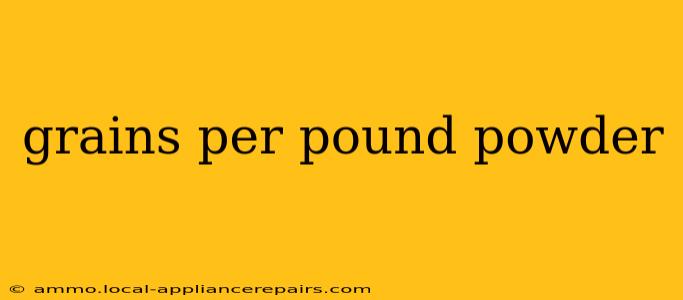Understanding the relationship between grains and pounds is crucial in various fields, from reloading ammunition and crafting precise recipes to understanding historical weight measurements and scientific calculations. This comprehensive guide will delve into the conversion process, explore its applications, and address common misconceptions.
What is a Grain?
Before diving into the conversion, let's clarify what a grain is. A grain (gr) is a unit of mass, historically defined as the weight of a single grain of barley. While seemingly insignificant, understanding grains is vital for accuracy in several domains. In the context of weight, one grain equals 0.06479891 grams. This seemingly small unit becomes significantly important when dealing with larger quantities or in situations demanding high precision.
Grains to Pounds Conversion: The Calculation
The core conversion is simple: there are 7,000 grains in one pound (lb). This means that to convert grains to pounds, you simply divide the number of grains by 7,000. Conversely, to convert pounds to grains, you multiply the number of pounds by 7,000.
Example Conversions:
- Grains to Pounds: Let's say you have 14,000 grains. Dividing 14,000 by 7,000 gives you 2 pounds.
- Pounds to Grains: You need 3 pounds converted to grains. Multiplying 3 by 7,000 gives you 21,000 grains.
Practical Applications of Grains Per Pound Conversion
This conversion isn't just a theoretical exercise; it has numerous practical applications across diverse fields:
1. Ammunition Reloading:
Precision is paramount in reloading ammunition. The weight of gunpowder is meticulously measured in grains to ensure consistent and safe performance. Understanding grains per pound allows reloaders to accurately calculate powder charges and maintain optimal ballistic performance. Incorrect measurements can lead to dangerous malfunctions.
2. Pharmaceutical and Chemical Industries:
In these industries, precise measurements are critical for accurate drug dosages and chemical reactions. While grams and milligrams are commonly used, understanding the grain system can be important when working with older formulas or historical data.
3. Culinary Arts (Historically):
While less common now, historical recipes might utilize grains as a unit of measurement for spices and ingredients. Understanding the conversion can aid in adapting these recipes for modern use.
4. Scientific Research & Experiments:
In certain scientific fields, particularly those dealing with older research papers or historical data, the grain unit might still be encountered. Converting to more modern units ensures consistency and accuracy in analysis and replication.
Common Misconceptions and Considerations
- Imperial vs. Metric: Remember that the grain is an imperial unit. Always be mindful of the units you're working with and ensure consistent application of conversion factors.
- Significant Figures: When performing calculations, pay attention to significant figures to maintain accuracy. The precision of your final answer should reflect the precision of your initial measurements.
- Rounding: When rounding, consider the context. In ammunition reloading, rounding errors can be dangerous, so precision is critical.
Conclusion
Understanding grains per pound is essential for accuracy and precision in various fields. Mastering this conversion ensures correct measurements, preventing errors, and maintaining safety in situations where precision is critical. By understanding the conversion, its applications, and potential pitfalls, you can confidently utilize this unit of measurement across many domains.

